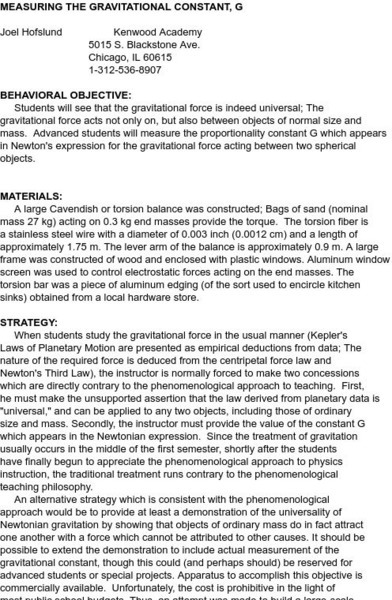Cosmos 4 kids
Cosmos4 Kids: Galaxy Cluster Basics
Understand what galaxy clusters are on this site which contains both information and a video.
Center of Science and Industry
Cosi Columbus: Balloon Rockets [Pdf]
Science experiment that demonstrates Newton's Third Law by launching rockets made out of balloons. Includes full list of materials, procedures, and scientific explanation of what causes balloons to shoot forward and how you can make them...
E-learning for Kids
E Learning for Kids: Science: Indian Ocean: What Are Mass Amd Weight?
Join Maria and Boris the Astronaut in their journey. Learn about mass, weight, and gravity in space.
PBS
Pbs Learning Media: Gravity of the Situation
Gravity of the Situation asks students to describe what role gravity plays on the movement of the three groups of kids in the video.
University of California
Ucla K 6 Physics/astronomy: Mass, Weight, and Density
This website provides explanations of mass, weight, and density with directions for building simple scales and balances. Provided as encouragement to teach these concepts to young children, it offers a good review for older students.
Wolfram Research
Wolfram Science World: Henry Cavendish (1731 1810)
Short biography of the shy chemist, Henry Cavendish. Some interesting personal information and background. Mentions all of his major work.
Texas Instruments
Texas Instruments: Acceleration Due to Gravity
Students will collect data of different massed cars and compare the acceleration down an incline.
Science and Mathematics Initiative for Learning Enhancement (SMILE)
Smile: Measuring the Gravitational Constant, G
A demonstration/lab idea for determining the numerical value of the universal gravitation constant using a torsion balance.
Science Education Resource Center at Carleton College
Serc: Using Egg Drop Activity to Promote Critical Thinking and Analysis Skills
In this multi-lesson hands-on inquiry activity, students will develop their critical thinking skills by designing and constructing an apparatus that will permit an egg to survive a nine foot fall. Given limited materials, they will...
Science Education Resource Center at Carleton College
Serc: Investigating Forces: Pop Bottle Rockets
In this lab, learners will work on scientific inquiry skills: observation, developing questions, conducting an experiment, and collecting data. They will investigate forces using pop bottle rockets that they have designed.
Science Education Resource Center at Carleton College
Serc: Exploring Magnetism: Investigating the Forces of Magnets
Students describe and create an experiment to prove that like poles of magnets repel each other while opposite poles attract. Using the experiment, they use the data to support the claim that the repelling force is stronger than the...
Science Education Resource Center at Carleton College
Serc: Measuring Reaction Time
Students investigate each other's reaction time by measuring how far a ruler falls before they can catch it. They will interpret the data and turn in a lab report describing the procedure they used and the results they discovered.
Science Education Resource Center at Carleton College
Serc: Marble Stop
In this two-part lesson plan, students will discover that no matter what the shape of the track, the marble will rise to the same vertical height. They will begin to understand the concepts of gravity, motion, and force.
Science Education Resource Center at Carleton College
Serc: Investigating Gravity: Predicting Time to Hit the Ground
Learners will drop and shoot horizontally "Nerf" balls from a variety of known heights then record the amount of time it takes for the ball to hit the ground for each trial. They will plot height vs. time data and create a trend line for...
Science Education Resource Center at Carleton College
Serc: Investigating Air Resistance
In this lab, young scholars will investigate what factors affect air resistance while introducing gravity and other forces.
Science Education Resource Center at Carleton College
Serc: Newton's Second: Having a Ball With Motion
Students will create a gravity ball launcher to demonstrate their understanding of mass, force, momentum, and motion. The students will use critical thinking, measurement, and observation and analysis of data to make changes and improve...
Science Education Resource Center at Carleton College
Serc: Egg Drop
In this physics lab, students build a container to safely deliver two eggs from the top of the school. Students calculate average velocity, acceleration, momentum, and the amount of force as it hits the ground. If their egg breaks, they...
Science Education Resource Center at Carleton College
Serc: Projectile and Satellite Orbits
This activity introduces gravity and Kepler's Laws and helps to develop an understanding of gravitational force, satellite orbits, and their dependence on the initial velocity.
Wikimedia
Wikipedia: The Black Hole
This site examines the black hole as an object in astrophysics. Delve into this comprehensive resource that covers this concept from its history, to qualitative physics, the reality of black holes, mathematical physics and more.
Wikimedia
Wikipedia: Gravitropism (Geotropism)
Gravitropism (or geotropism) is how a plant responds to gravity. Roots have a positive reaction to gravity and they grow toward it. Stems have a negative reaction and grow away from gravity. Learn more about what happens inside a plant...
Wikimedia
Wikipedia: Centripetal Force
Wikipedia's site on centripetal force provides a section explaining the difference between centripetal force and centrifugal force. Includes formulas and hyperlinked terms.
Wikimedia
Wikipedia: Centrifuge
Wikipedia provides detailed information and history on centrifuges in scientific research and industry, including its importance in making nuclear weapons.
Project Britain
Primary Homework Help: Forces Quiz
First, read some fast facts about forces, then take a ten-question, multiple-choice quiz. Check to see if your answers are correct after each question.
PBS
Pbs Kids: Dragonfly Tv: Do It: Balancing Act
An experiment kids can do at home to discover how the center of gravity can affect whether things will balance or not.

![Cosi Columbus: Balloon Rockets [Pdf] Activity Cosi Columbus: Balloon Rockets [Pdf] Activity](https://static.lp.lexp.cloud/images/attachment_defaults/resource/large/FPO-knovation.png)



















